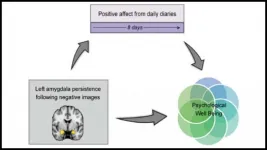(Press-News.org) A large study of brain MRI scans from 11,679 nine- and ten-year-old children reviewed by UC San Francisco neuroradiologists identified potentially life-threatening conditions in 1 in 500 children, and more minor but possibly clinically significant brain abnormalities in 1 out of 25 children.
The results provide the best estimates to date of the true incidence of various structural abnormalities in the developing brain, and raise the question of whether all MRI brain imaging obtained during research studies should be reviewed by board-certified radiologists, as was done in this study, in the hopes of saving lives and alerting participants to incidental findings that ought to be medically evaluated.
One parent went public on Facebook with good news following her son's recovery from successful surgery to remove a brain tumor that was detected by the reviewing UCSF neuroradiologists, writing, "I'm forever grateful because his participation in this study probably saved his life."
The senior author of the study, published March 22, 2021 in JAMA Neurology, is Leo Sugrue, MD, PhD, associate professor in the UCSF Department of Radiology and director of the Laboratory for Precision Neuroimaging. "From examining brain MRIs in this large, demographically diverse sample of U.S. kids, now we know with good statistical reliability how common various brain abnormalities are in the general population," Sugrue said.
Abnormalities for which additional medical evaluation was recommended included cysts that might grow to impinge on key brain structures, and developmental abnormalities of the brain's grey matter that have been associated with seizures.
About 21 percent of kids in the study had some structural finding in the brain; however, many were simply anatomical variants, such as an unusually shaped structure, that are not known to be clinically significant. All the participating children will continue to be scanned every two years over the 10-year study, and Sugrue says some of the outstanding questions are whether any of these structural brain abnormalities statistically correlate with developmental outcomes being tracked in the study, or whether some - growing cysts, for example - may become more abnormal over time.
The results are some of the first to emerge from the ongoing nationwide Adolescent Brain Cognitive Development (ABCD) study, launched by collaborating institutes within the National Institutes of Health. The ABCD study, which has enrolled participants at 21 different research sites across the country, is the biggest U.S. long-term study of child health and brain development to date.
While the results presented in JAMA Neurology are from initial baseline MRI scans, the ambitious, overarching goal of the ABCD study is to reevaluate the same cohort of children periodically as they mature from pre-adolescence through adulthood, to determine how changing biology interacts with environment and lifestyle - variables such as involvement in sports, use of social media and video games, sleep patterns, and use of substances such as alcohol and tobacco -- to influence brain development and health, including behavioral, social, and educational outcomes.
Adolescence is a time of dramatic changes in brain structure and function, Sugrue said. "The years from adolescence to early adulthood are a time of rapid social, cognitive, and emotional development, and a period when many psychiatric disorders and learning disabilities first present. Brain changes during this period are suspected to influence risk for disorders such as schizophrenia, depression, attention-deficit/hyperactivity disorder, and addiction. However, to date our understanding of those relationships has been limited by a lack of high-quality longitudinal data, a gap that the ABCD study aims to fill."
Besides obtaining brain images, ABCD researchers are administering questionnaires and neuropsychiatric exams, taking blood and other biosamples for genetic and other studies, and even consulting geographical databases to monitor participants' exposure to pollution and other environmental factors.
Although researchers are obtaining a variety of additional types of MRI images for the ABCD study, the results published this week in JAMA Neurology were obtained through review of structural scans obtained using state-of-the-art imaging with high-field-strength MRI scanners that allow examination of the brain at millimeter resolution.
Sugrue and UCSF neuroradiologist Yi Li, MD, the first author of the new study and assistant professor in the Department of Radiology, evaluated all the baseline structural MRI scans for the ABCD study, but Sugrue has recently recruited additional UCSF clinical neuroradiologists to assist in future analyses. UCSF is not an enrollment or exam site for the ABCD study.
ABCD study researchers recruited participants for intake and first evaluation between 2016 and 2018. While over half of the 2-year follow-up exams have been completed, COVID19 has slowed progress in data collection. But because of the timing of the study, researchers will now be able to investigate the potential influence of COVID19 on risks for the outcomes being evaluated.
INFORMATION:
Leading co-authors on the study included Terry Jernigan, Anders Dale, and Wesley Thompson of UC San Diego.
Funding: The study was funded by the National Institutes of Health.
Disclosures: None.
About UCSF: The University of California, San Francisco (UCSF) is exclusively focused on the health sciences and is dedicated to promoting health worldwide through advanced biomedical research, graduate-level education in the life sciences and health professions, and excellence in patient care. UCSF Health, which serves as UCSF's primary academic medical center, includes top-ranked specialty hospitals and other clinical programs, and has affiliations throughout the Bay Area. Learn more at ucsf.edu, or see our Fact Sheet.
Follow UCSF
ucsf.edu | Facebook.com/ucsf | YouTube.com/ucsf
How the amygdala responds to viewing negative and subsequent neutral stimuli may impact our daily mood, according to new research published in JNeurosci.
The amygdala evaluates the environment to find potential threats. If a threat does appear, the amygdala can stay active and respond to new stimuli like they are threatening too. This is helpful when you are in a dangerous situation, but less so when spilling your coffee in the morning keeps you on edge for the rest of the day.
In a recent study, Puccetti et al. examined data collected from the "Midlife ...
MINNEAPOLIS/ST.PAUL (03/22/2021) -- New research from the University of Minnesota Medical School suggests that disease-driving B cells, a white blood cell, play a role in the development of non-alcoholic fatty liver disease (NAFLD) - the most common chronic liver condition in the U.S. Their findings could lead to targeted therapies for NAFLD, which currently affects a quarter of the nation and has no FDA-approved treatments.
After noticing that patients with the disease showed a large number of inflammatory B cells in their livers, Xavier Revelo, PhD, an assistant professor in the Department of Integrative Biology and Physiology and senior author, began studying B cells in NAFLD.
"This disease is increasing in prevalence ...
Although Tuberculosis, or TB, killed nearly as many people as COVID-19 (approx. 1.8 million) in 2020, it did not receive as much media and public attention. The pandemic has proven that transmissible infection is indeed a global issue. TB remains a serious public health concern in Ireland, particularly with the presence of multi-drug resistant types and the numbers of complex cases here continuing to rise, with cases numbering over 300 annually.
Science tells us that iron is crucial for daily human function, but it is also an essential element for the survival of ...
Batteries charge and recharge--apparently all thanks to a perfect interplay of electrode material and electrolyte. However, for ideal battery function, the solid electrolyte interphase (SEI) plays a crucial role. Materials scientists have now studied nucleation and growth of this layer in atomic detail. According to the study published in the journal Angewandte Chemie, the properties of anions and solvent molecules need to be well balanced.
In lithium-ion batteries, the SEI forms at the beginning of the first charging process, when a potential is applied. Elements from the electrolyte deposit on the graphite electrode and form a coating that soon ...
Antibiotics have revolutionized the field of medicine by making it possible to treat most known microbial diseases today. However, their uncontrolled usage has led to the major global problem of antibiotic resistance. As we continue to exploit antibiotics, sometimes at doses much higher than needed, disease-causing bacteria are rapidly evolving defense strategies to evade them. These drug-resistant bacteria, also known as "superbugs," cause severe infections that are difficult to treat and can eventually be fatal.
Methicillin-resistant Staphylococcus aureus (MRSA), a particularly vicious group of superbugs that have developed resistance to the antibiotic methicillin, is a major cause of hospital-acquired infections. Accurate and timely diagnosis ...
Boulder, Colo., USA: Beneath the cold, dark depths of the Arctic ocean sit vast reserves of methane. These stores rest in a delicate balance, stable as a solid called methane hydrates, at very specific pressures and temperatures. If that balance gets tipped, the methane can get released into the water above and eventually make its way to the atmosphere. In its gaseous form, methane is one of the most potent greenhouse gases, warming the Earth about 30 times more efficiently than carbon dioxide. Understanding possible sources of atmospheric methane is critical for accurately predicting future climate change.
In the Arctic Ocean today, ice sheets exert pressure on the ground below them. That pressure diffuses ...
Screenings for breast cancer and colon cancer dropped dramatically during the early months of the coronavirus pandemic, but use of the procedures returned to near-normal levels by the end of July 2020, according to a new study.
Analyzing insurance claims from more than 6 million Americans with private health coverage, researchers found that mammography rates among women aged 45 to 64 declined by 96% during March and April 2020 as compared to January and February.
Similarly, the weekly rate of colorectal cancer screenings among adults aged 45 to 64 and older declined by 95% during the period.
By the end of July 2020, however, the rate of mammograms among women had rebounded and was slightly higher than it had been before the pandemic was declared. The rate of colonoscopies also rebounded, ...
Researchers at Trinity College Dublin have been shedding light on the enigmatic "spiders from Mars", providing the first physical evidence that these unique features on the planet's surface can be formed by the sublimation of CO2 ice.
Spiders, more formally referred to as araneiforms, are strange-looking negative topography radial systems of dendritic troughs; patterns that resemble branches of a tree or fork lightning. These features, which are not found on Earth, are believed to be carved into the Martian surface by dry ice changing directly from solid to gas (sublimating) in the spring. Unlike Earth, Mars' atmosphere comprises mainly of CO2 and as temperatures decrease in winter, this deposits onto the surface as CO2 ...
Optical resonators provide the foundation of modern photonics and optics. Thanks to its extreme energy confinement, the high-Q-factor optical resonator optimizes light-matter interaction and photonic device performance by enabling low-threshold laser and enhanced nonlinear harmonic generation.
Two typical structures, the photonic crystal cavity and the whispering gallery cavity, are frequently used to obtain extremely high-Q factors. However, these structures may require dimensions that are comparable to--or several times larger than--the operating wavelength. Whether there is a general way to find out all high-Q modes in a dielectric ...
The tuberculosis (TB) burden in the WHO European Region as a whole is decreasing, and is down 19% overall for 2015-2019, according to the latest WHO/European Centre for Disease Prevention and Control (ECDC) report Tuberculosis surveillance and monitoring in Europe 2021 (2019 data).
Regional TB mortality has gone down, declining by 9.4% between 2018 and 2019. This is notably higher than the average global decline in TB mortality (3.7%) and enough to have reached the End TB Strategy milestone of a 35% reduction by 2020 compared to 2015.
However, TB is second only to COVID-19 as an infectious disease that kills, and drug resistance is a major concern. There are also worrying indications that the COVID-19 pandemic may stall progress or cause significant setbacks in the fight against TB.
The ...




